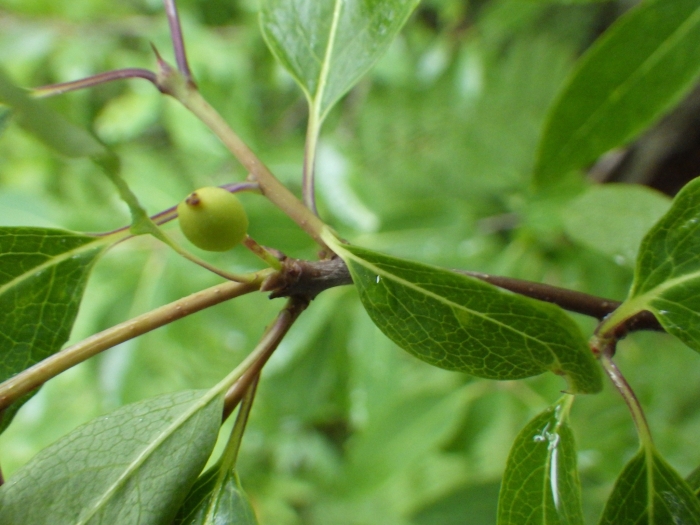Mountain Holly
(Ilex mucronata)
Mountain Holly (Ilex mucronata)
/
/

Ben Armstrong
CC BY 4.0
Image By:
Ben Armstrong
Recorded By:
Copyright:
CC BY 4.0
Copyright Notice:
Photo by: Ben Armstrong | License Type: CC BY 4.0 | License URL: http://creativecommons.org/licenses/by/4.0/ | Rights Holder: Ben Armstrong | Publisher: iNaturalist | Date Created: 2018-07-21T17:50:46-07:00 |






















































Estimated Native Range
Summary
Ilex mucronata, commonly known as Mountain Holly, is a deciduous shrub native to acidic wetlands, including bogs, swamps, and wet woods in the Northeastern USA and Eastern Canada. It typically grows to about 3 meters tall and has a rounded form. The leaves are elliptical and come to a pointed tip, resembling those of holly species, hence the common name. The small, inconspicuous flowers are whitish to greenish-yellow, about 1/5" in diameter with 4 to 5 petals, and are produced on slender peduncles 25 mm or more long. Mountain Holly is usually dioecious, with male and female flowers on separate plants. The fruit is a notable red drupe, 6–7 mm in diameter, containing three to five pits, which can persist into winter and provide food for birds.
Mountain Holly is valued for its wildlife support and its yellow autumn coloration. It is often used in naturalistic plantings and restoration projects. While it does best in full sun, it can also tolerate partial shade. It is adaptable to a range of soil drainage conditions, from slow to fast, but prefers consistently moist, acidic soils. It is hardy in USDA zones 4 to 6. Gardeners should be aware that while it is not known for serious disease or pest issues, it can suffer from leaf spot and may require extra water during dry periods.CC BY-SA 4.0
Mountain Holly is valued for its wildlife support and its yellow autumn coloration. It is often used in naturalistic plantings and restoration projects. While it does best in full sun, it can also tolerate partial shade. It is adaptable to a range of soil drainage conditions, from slow to fast, but prefers consistently moist, acidic soils. It is hardy in USDA zones 4 to 6. Gardeners should be aware that while it is not known for serious disease or pest issues, it can suffer from leaf spot and may require extra water during dry periods.CC BY-SA 4.0
Plant Description
- Plant Type: Shrub
- Height: 6-15 feet
- Width: 2-6 feet
- Growth Rate: Moderate
- Flower Color: N/A
- Flowering Season: Spring, Summer
- Leaf Retention: Deciduous
Growth Requirements
- Sun: Full Sun, Part Shade
- Water: Medium
- Drainage: Slow, Medium, Fast
Common Uses
Bee Garden, Bird Garden, Butterfly Garden, Deer Resistant, Low Maintenance, Rabbit Resistant, Water Garden
Natural Habitat
Acidic wetlands, including bogs, swamps, and wet woods
Other Names
Common Names: Catberry
Scientific Names: , Nemopanthus mucronatus, Ilex mucronata, Nemopanthus mucronata, Nemopanthus fascicularis, Nemopanthus canadensis, Nemopanthes mucronata, Vaccinium mucronatum, Ilicioides mucronata, Nemopanthes canadensis
GBIF Accepted Name: Ilex mucronata (L.) M.Powell, Savol. & S.Andrews